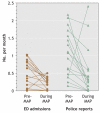Shelter-based managed alcohol administration to chronically homeless people addicted to alcohol
- PMID: 16389236
- PMCID: PMC1319345
- DOI: 10.1503/cmaj.1041350
Shelter-based managed alcohol administration to chronically homeless people addicted to alcohol
Abstract
Background: People who are homeless and chronically alcoholic have increased health problems, use of emergency services and police contact, with a low likelihood of rehabilitation. Harm reduction is a policy to decrease the adverse consequences of substance use without requiring abstinence. The shelter-based Managed Alcohol Project (MAP) was created to deliver health care to homeless adults with alcoholism and to minimize harm; its effect upon consumption of alcohol and use of crisis services is described as proof of principle.
Methods: Subjects enrolled in MAP were dispensed alcohol on an hourly basis. Hospital charts were reviewed for all emergency department (ED) visits and admissions during the 3 years before and up to 2 years after program enrollment, and the police database was accessed for all encounters during the same periods. The results of blood tests were analyzed for trends. A questionnaire was administered to MAP participants and staff about alcohol use, health and activities of daily living before and during the program. Direct program costs were also recorded.
Results: Seventeen adults with an average age of 51 years and a mean duration of alcoholism of 35 years were enrolled in MAP for an average of 16 months. Their monthly mean group total of ED visits decreased from 13.5 to 8 (p = 0.004); police encounters, from 18.1 to 8.8 (p = 0.018). Changes in blood test findings were nonsignificant. All program participants reported less alcohol consumption during MAP, and subjects and staff alike reported improved hygiene, compliance with medical care and health.
Interpretation: A managed alcohol program for homeless people with chronic alcoholism can stabilize alcohol intake and significantly decrease ED visits and police encounters.
Figures
Comment in
-
Homelessness and harm reduction.CMAJ. 2006 Jan 3;174(1):50-1. doi: 10.1503/cmaj.051505. CMAJ. 2006. PMID: 16389237 Free PMC article. No abstract available.
-
Dealing with alcoholism.CMAJ. 2006 Aug 29;175(5):502; author reply 502-3. doi: 10.1503/cmaj.1060020. CMAJ. 2006. PMID: 16940273 Free PMC article. No abstract available.
References
-
- Gelberg L, Leake BD. Substance use among impoverished medical patients: the effect of housing status and other factors. Med Care 1993;31:757-66. - PubMed
-
- Fichter M, Quadflieg N. Alcoholism in homeless men in the mid-nineties: results from the Bavarian Public Health Study on homelessness. Eur Arch Psychiatry Clin Neurosci 1999;249:34-44. - PubMed
-
- Welte JW, Barnes GM. Drinking among homeless and marginally housed adults in New York State. J Stud Alcohol 1992;53:303-15. - PubMed
-
- Gregoire TK. Subtypes of alcohol involvement and their relationships to exits from homelessness. Subst Use Misuse 1996;31:1333-57. - PubMed
Publication types
MeSH terms
LinkOut - more resources
Full Text Sources
Medical

